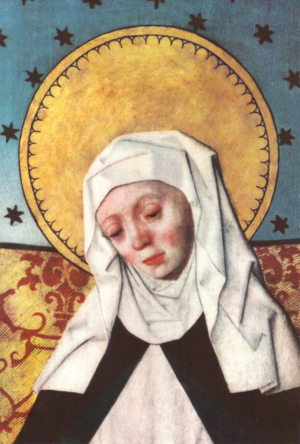Long before Sweden was known for ABBA and IKEA – two exports not to everyone’s taste, even if billion-dollar brands – along with a soft, but moribund, version of socialism,, the northern nation was was a land of saints, of a people devoted to the Faith, after the conversion of the Baltic regions between the 8th an 12th centuries. And one of the greatest in this panoply is the noble Bridget, whom we celebrate on this day, when she went to eternity in 1373 in her 70th year.
She was married young, to Ulf Gudmarsson, and bore eight children, six of whom survived to adulthood – a rarity in those days. One of them, Catherine, also went on to become a canonized saint, even more of a rarity in any day. In 1341, Bridget and her husband made the pilgrimage to Santiago de Compostela (the feast of Saint James is on the 25th of this month, so stay tuned), after which they pledged themselves mutually to a life of continence. Ulf went to his own reward a few years later, in 1344.
Bridget then joined the Third Order of Saint Francis, and devoted the rest of her life to caring for the poor and the sick – and this during the Black Death (1347-51). No sheltering in place for her, but off to tend those who needed succour.
The work was so vast, she realized the need for a new community, and so founded the Order of the Most Holy Saviour, commonly known now as the Brigittines, with their distinctive veil and habit. The Order was unique in being composed of both men and women – suitably distanced in separate quarters – but governed by an Abbess, who would represent the Blessed Virgin. They practised poverty, but were not quite Franciscans, as Bridget, a lover of learning, wrote in the rule that they could own as many books as they wanted. Hmm.
With her daughter and some priests, she made a pilgrimage to Rome in 1349 for the Jubilee year of 1350, braving a plague-ridden Europe to seek approval for the new Order, which, due to the exile of the papacy to Avignon, had to wait for the return of the Pope to Rome (they did not receive official approval until 1370 by Pope Urban V). Bridget stayed in Rome, with the exception of some pilgrimages, including one to the Holy Land, directing her Order from the centre of Christendom, like her near-contemporary, Catherine of Siena, urging ecclesiastical reform. She went to confession everyday – not recommended for all, but each path is unique – and was also known for the radiant joy beaming from her face. We may wonder how much such reform depended upon such spirited and spiritual women.
From the age of ten, Bridget had received visions from and of Christ, especially of His Nativity and His Passion, which she recounted and recorded, known as the Revelationes Celestes (the ‘Celestial Revelations’), and which very much influenced late-mediaeval and early renaissance spirituality and art. As with all private revelations, we are not bound to have divine faith in them, but they are given to lead us, or some of us, or at least Bridget herself, to live our own Faith more fully. Apparently, she predicted the precise boundaries of the future Vatican City State, under Mussolini, in 1929, which, if accepted back in Bridget’s day, would have saved a lot of bother with the whole papal states controversy in the intervening six centuries. Oh, if the Church listened to her saints more often…
After her death in 1373, Bridget was hailed for her holiness, and was canonized less than two decades later in 1391 by Pope Boniface IX, a decree confirmed by the Council of Constance in 1415. She is also counted one of the six patron saints of Europe (as decreed by Pope John Paul II’s motu proprio of October 1st, 1999, Spes Aedificandi, in which he also added Catherine of Siena and Theresa Benedicta as patronesses of the continent, on the eve of our own Jubilee Year).
Quite the woman, and we could use a few more of her mettle.
Saint Bridget of Sweden, ora pro nobis!











